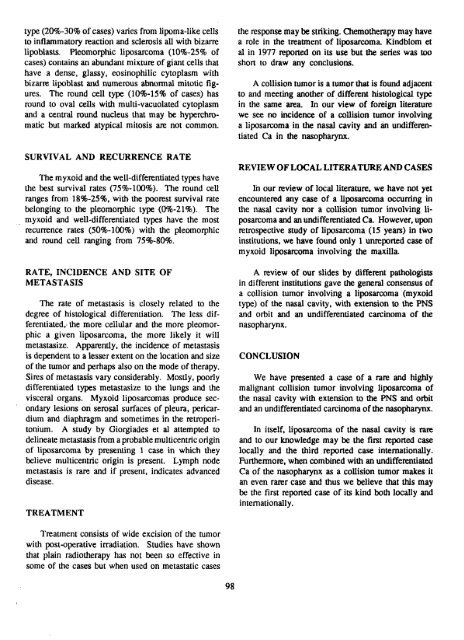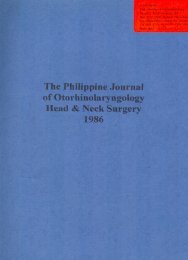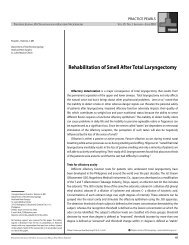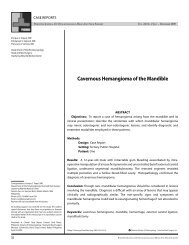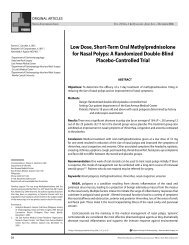Create successful ePaper yourself
Turn your PDF publications into a flip-book with our unique Google optimized e-Paper software.
type (20%-30% of cases) varies from lipoma-like ceils the response may be striking. Chemotherapy may have<br />
to inflammatory reaction and sclerosis all with bizarre a role in the treatment of liposarcoma. Kindblom et<br />
lipoblasts. Pleomorphic liposarcoma (10%-25% of al in 1977 reported on its use but the series was too<br />
cases) contains an abundant mixture of giant ceils that short to draw any conclusions.<br />
have a dense, glassy, eosinophilic cytoplasm with<br />
bizarre lipoblast and numerous abnormal mitotic fig- A collision tumor is a tumor that is found adjacent<br />
ures. The round cell type (10%-15% of cases) has to and meeting another of different histological type<br />
round to oval cells with multi-vacuolated cytoplasm in the samearea. In our view of foreign literature<br />
and a central round nucleus that may be hyperchro- we see no incidence of a collision tumor involving<br />
matic but marked atypical mitosis are not common, a liposarcoma in the nasal cavity and an undifferentiated<br />
Ca in the nasopharynx.<br />
SURVIVAL AND RECURRENCE RATE<br />
REVIEW OF LOCAL LITERATURE AND CASES<br />
The myxoid and the well-differentiated types have<br />
the best survival rates (75%-100%). The round cell In our review of local literature, we have not yet<br />
ranges from 18%-25%, with the poorest survival rate encountered any case of a llposarcoma occurring in<br />
belonging to the pleomorphic type (0%-21%). The the nasal cavity nor a collision tumor involving limyxoid<br />
and well-differentiated types have the most posarcoma and an undifferentiated Ca. However, upon<br />
recurrence rates (50%-100%) with the pleomorphic retrospective study of liposarcoma (15 years) in two<br />
and round cell ranging from 75%-80%. institutions, we have found only 1 unreported case of<br />
myxoid liposarcoma involving the maxilla.<br />
RATE, INCIDENCE AND SITE OF A review of our slides by different pathologists<br />
METASTASIS in different institutions gave the general consensus of<br />
a collision tumor involving a liposarcoma (myxoid<br />
The rate of metastasis is closely related to the type) of the nasal cavity, with extension to the PNS<br />
degree of histological differentiation. The less dif- and orbit and an undifferentiated carcinoma of the<br />
ferentiated,, the more cellular and the more pleomor- nasopharynx.<br />
phic a given liposarcoma, the more likely it will<br />
metastasize. Apparently, the incidence of metastasis<br />
is dependent to a lesser extent on the location and size CONCLUSION<br />
of the tumor and perhaps also on the mode of therapy.<br />
Sires of metastasis vary considerably. Mostly, poorly We have presented a case of a rare and highly<br />
differentiated types metastasize to the lungs and the malignant collision tumor involving liposarcoma of<br />
visceral organs. Myxoid liposarcomas produce sec- the nasal cavity with extension to the PNS and orbit<br />
ondary lesions on serosal surfaces of pleura, pericar- and an undifferentiated carcinoma of the nasopharynx.<br />
dium and diaphragm and sometimes in the retroperitonium.<br />
A study by Giorgiades et al attempted to In itself, liposarcoma of the nasal cavity is rare<br />
delineate metastasis from aprobable multicentric origin and to our knowledge may be the first reported case<br />
of liposarcoma by presenting 1 case in which they locally and the third reported case internationally.<br />
believe multicentric origin is present, Lymph node Furthermore, when combined with an undifferentiated<br />
metastasis is rare, and if present, indicates advanced Ca of the nasopharynx as a collision tumor makes it<br />
disease,<br />
an even rarer case and thus we believe that this may<br />
be the first reported case of its kind both locally and<br />
internationally,<br />
TREATMENT<br />
Treatment<br />
consists of wide excision of the tumor<br />
with post-operative irradiation. Studies have shown<br />
that plain radiotherapy has not been so effective in<br />
some of the cases but when used on metastatic cases<br />
98


